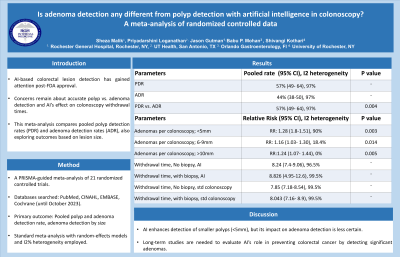Sunday Poster Session
Category: Colon
P0234 - Is Adenoma Detection Any Different From Polyp Detection With Artificial Intelligence in Colonoscopy? A Meta-Analysis of Randomized Controlled Data
Sunday, October 27, 2024
3:30 PM - 7:00 PM ET
Location: Exhibit Hall E


Sheza Malik, MD
Rochester General Hospital
Rochester, NY
Presenting Author(s)
Sheza Malik, MD1, Priyadarshini Loganathan, MD2, Gutman Jason, MD1, Babu Mohan, MD3, Shivangi Kothari, MD4
1Rochester General Hospital, Rochester, NY; 2UT Health, San Antonio, TX; 3Orlando Gastroenterology PA, Orlando, FL; 4University of Rochester, Rochester, NY
Introduction: Artificial intelligence (AI) based detection of colorectal lesions has gathered a lot of attention, especially after the approval of the Food and Drug Administration. However, there is concern about the accurate detection of polyps versus adenomas and differences in withdrawal times with AI. In this meta-analysis, we compare pooled polyp detection rates (PDR) and adenoma detection rates (ADR) using AI while also exploring outcomes based on lesion size.
Methods: Our study followed PRISMA guidelines and searched PubMed, CINAHL, EMBASE, and Cochrane databases from inception to December 2023. We computed pooled rates for polyp and adenoma detection, lesion miss rates, and adenoma detection by size. Our secondary outcomes focussed on withdrawal times with the use of AI. Standard meta-analysis methods were employed using the random-effects model, and heterogeneity was assessed using the I2% values.
Results: We analyzed 21 randomized control trials. The pooled PDR with AI was 57% (95% CI 49- 64) I2 97%, and the ADR with AI was 44% (95% CI 38-50) I2 97%. The PDR vs ADR was statistically significant, with a p-value of 0.004. For polyps < 5mm, the pooled RR was 1.28 (1.8-1.51) I2 90 % with AI as compared to standard colonoscopy. Similarly, pooled RR for polyps 5-10 mm and >10 mm were as follows: 1.16 (1.03- 1.30) I2 18.4% and 1.24 (1.07- 1.44)I2 0%. In terms of withdrawal times with AI-assisted colonoscopy, the pooled meantime was slightly longer with AI-aided colonoscopy than standard colonoscopy (8.24 min vs 7.85 min for no biopsy and 8.826 min vs 8.043 min with biopsy).
Discussion: In conclusion, our meta-analysis indicates that AI-enhanced colonoscopy excels in detecting smaller polyps (< 5mm) but is less effective in identifying adenomas, a key factor in colorectal neoplasia prevention. The clinical relevance of detecting sub-5mm polyps remains uncertain, underscoring the necessity for long-term studies to assess AI's impact on the detection of clinically significant adenomas and its role in mitigating colorectal cancer development.
Note: The table for this abstract can be viewed in the ePoster Gallery section of the ACG 2024 ePoster Site or in The American Journal of Gastroenterology's abstract supplement issue, both of which will be available starting October 27, 2024.
Disclosures:
Sheza Malik, MD1, Priyadarshini Loganathan, MD2, Gutman Jason, MD1, Babu Mohan, MD3, Shivangi Kothari, MD4. P0234 - Is Adenoma Detection Any Different From Polyp Detection With Artificial Intelligence in Colonoscopy? A Meta-Analysis of Randomized Controlled Data, ACG 2024 Annual Scientific Meeting Abstracts. Philadelphia, PA: American College of Gastroenterology.
1Rochester General Hospital, Rochester, NY; 2UT Health, San Antonio, TX; 3Orlando Gastroenterology PA, Orlando, FL; 4University of Rochester, Rochester, NY
Introduction: Artificial intelligence (AI) based detection of colorectal lesions has gathered a lot of attention, especially after the approval of the Food and Drug Administration. However, there is concern about the accurate detection of polyps versus adenomas and differences in withdrawal times with AI. In this meta-analysis, we compare pooled polyp detection rates (PDR) and adenoma detection rates (ADR) using AI while also exploring outcomes based on lesion size.
Methods: Our study followed PRISMA guidelines and searched PubMed, CINAHL, EMBASE, and Cochrane databases from inception to December 2023. We computed pooled rates for polyp and adenoma detection, lesion miss rates, and adenoma detection by size. Our secondary outcomes focussed on withdrawal times with the use of AI. Standard meta-analysis methods were employed using the random-effects model, and heterogeneity was assessed using the I2% values.
Results: We analyzed 21 randomized control trials. The pooled PDR with AI was 57% (95% CI 49- 64) I2 97%, and the ADR with AI was 44% (95% CI 38-50) I2 97%. The PDR vs ADR was statistically significant, with a p-value of 0.004. For polyps < 5mm, the pooled RR was 1.28 (1.8-1.51) I2 90 % with AI as compared to standard colonoscopy. Similarly, pooled RR for polyps 5-10 mm and >10 mm were as follows: 1.16 (1.03- 1.30) I2 18.4% and 1.24 (1.07- 1.44)I2 0%. In terms of withdrawal times with AI-assisted colonoscopy, the pooled meantime was slightly longer with AI-aided colonoscopy than standard colonoscopy (8.24 min vs 7.85 min for no biopsy and 8.826 min vs 8.043 min with biopsy).
Discussion: In conclusion, our meta-analysis indicates that AI-enhanced colonoscopy excels in detecting smaller polyps (< 5mm) but is less effective in identifying adenomas, a key factor in colorectal neoplasia prevention. The clinical relevance of detecting sub-5mm polyps remains uncertain, underscoring the necessity for long-term studies to assess AI's impact on the detection of clinically significant adenomas and its role in mitigating colorectal cancer development.
Note: The table for this abstract can be viewed in the ePoster Gallery section of the ACG 2024 ePoster Site or in The American Journal of Gastroenterology's abstract supplement issue, both of which will be available starting October 27, 2024.
Disclosures:
Sheza Malik indicated no relevant financial relationships.
Priyadarshini Loganathan indicated no relevant financial relationships.
Gutman Jason indicated no relevant financial relationships.
Babu Mohan indicated no relevant financial relationships.
Shivangi Kothari indicated no relevant financial relationships.
Sheza Malik, MD1, Priyadarshini Loganathan, MD2, Gutman Jason, MD1, Babu Mohan, MD3, Shivangi Kothari, MD4. P0234 - Is Adenoma Detection Any Different From Polyp Detection With Artificial Intelligence in Colonoscopy? A Meta-Analysis of Randomized Controlled Data, ACG 2024 Annual Scientific Meeting Abstracts. Philadelphia, PA: American College of Gastroenterology.
